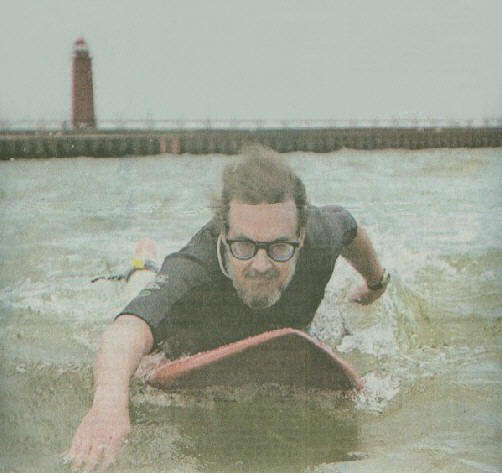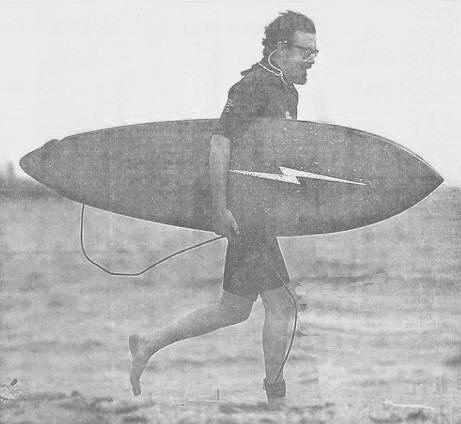
Grand Rapids Press August 7, 2004
The ‘Aquadoc’
Big waves can be fatal; for 57-year-old surfer they’re divine
By Barbara Beal Schmid
The Grand Rapids Press

PRESS PHOTO/LIZ OROZCO
Ride the Mild surf: Bob Beaton paddles his surfboard recently along the beach at Ferrysburg. He routinely plans his day around lake Michigan wind and waves.
Bob Beaton is still a surfer dude — at age 57.
It’s what gets him out of bed each morning; it’s what he dreams about at night. Put a southwest wind on the weather forecast for Grand Haven and it’s a safe bet the “Aquadoc” will be at the South Pier rock pile chasing down the waves with surfers more than half his age.
“Doc is one of a handful of Great Lakes surfers I know over 50 that are in the legend category,” said Vince Deur, a Grand Haven film producer who is releasing a documentary about Great Lakes surfing on PBS in February.
“He’s treating surfing like a profession. I’ve seen footage of him surfing in the 70s and he was always wily in the sense he could stay up regardless. The waves here can be choppy and bumpy and he’d be able to take the ride from all the way out to all the way in.
“I’ve seen a similar shot of him doing that even into his fifties. A lot of guys had to gine up surfing. It was too difficult keep chasing after. But he stayed true.
Beaton started surfing in 1962 when beach-themed movies romanticized the sport with scenes of bronzed athletes catching every wave, bikini-clad women basking in the sun, and all-night parties on the beach. Now, modern films and ESPN’s X-Games have put the sport back in the spotlight.
“The early sixties is when the surfing craze first hit nationwide,” said Beaton of Fruitport. “My friends and I had 13-foot sailfishes. We decided to take the masts off, but left the tiller and rudder on them. Those became our first surfboards.
Beaton and his buddies, whose families summered in Grand Haven, were finally able to pool their resources to buy a Malibu longboard for about $25. They called it “The Banana” for its bright yellow hue. Grand Haven summers were suddenly transformed from “ho-hum” to “hot dog!”
Beaton was hooked.
While attending Aquinas College, where he earned a bachelors in history and geography, shortboards came into vogue to better handle steep waves with power. In search of bigger waves, Beaton spent his Christmas, spring and summer breaks along Florida’s Gulf Coast, Nags Head and Kitty Hawk, N.C. and the Pacific side of Mexico.
“We’d save all our money and go down in the late fall or early winter and find a trailer park,” Beaton said. “We mostly lived in a tent. We’d stay down there until our visa ran out. We didn’t do much night life. We just went down there to surf. It only cost us a couple of bucks night, so we could stay down there six to seven months on $600 to $700.
“In San Blas, the water breaks for a whole mile on a bay surrounded by banana plantations. You’re in a wave about 20 minutes. You just keep going and going and going. The wave never closes out, it just peels and peels.”
Those conditions are dramatically different from Lake Michigan waves, which break every 5-6 seconds and reach 4-5 feet on a good surfing day in the fall. September is the best month for surfing the Great Lakes, because the waves get steeper and yet the water temperature hasn’t dipped in the refrigerator zone. It’s Beaton’s favorite month to surf.
Yet any day is a good day to surf if the conditions are right. Beaton routinely plans his day around the wind and waves. While drinking his first cup of coffee each morning, he boots up his computer. His home page is set to the live beach camera at Grand Haven.
“:Surfers live on weather data,” Beaton said. “I check the buoys in Lake Michigan. There’s one off Frankfort and one off South Haven, Muskegon and New buffalo. We didn’t have this technology years ago. We had to look at the marine forecasts.”
By surfing online instead of in the water, Beaton admits to also learning of several surfing hot spots along the Great Lakes that he otherwise wouldn’t have known about. Beaton’s favorite Michigan surf destination is Michigan City inside the harbor where “a northeast wind will kick up ocean-quality waves,” he said.
SURFING HOT SPOTS
■North Muskegon breakwater with a south direction wind.
■Grand Haven South Pier with a south-southwest wind.
■Lee side of Grand Haven North Pier with a west-southwest wind.
■Consumers Power Pier at Pt. Sheldon with a big north-northwest.
■South side of South Haven with a north-northwest wind.
■West beach of New Buffalo with a north wind.
■Michigan City inside harbor with a northeast wind.
Beaton, a self-described information junkie, has spent hundreds of hours researching the history of Grand Haven from old newspapers. He started a Web site, www.sandhillcity.com, dedicated to indexing more than 6,000 articles from 1891 to 1917. Each month his Web site features stories that correspond with that month in history.
He also chaired the Grand Haven Pier Safety Task force from 1988-1996, an organization formed after several pier deaths in 1980.
“He’s an avid historian and greatly respected for his wealth of knowledge,” Deur said. “What amazes me is his focus — for his Web site, beach and pier safety and his surfing. He’s learned from history and applies it to now. It’s always been something I admired.”
Others have admired the surfer for the dramatic rescue he made on Nov. 10, 1975, the same night the Edmund Fitzgerald went down. That night, Beaton saved a boy from drowning in 14-foot surf off Grand Haven, for which he was later awarded a Congressional Lifesaving Medal.
Big waves can be fatal, yet for surfers they’re divine. A creative, if not quirky bunch, surfers will do almost anything to find clean faces and curls.
In the 2003 surfing documentary “Step Into Liquid,” surfers are shown getting towed by jet skis past the breakers off Maui. In Texas, surfers head out to shipping channels to surf waves produced by large ships. In Lake Michigan, they put on full wet suits and wipe icicles off their beards for the chance to play in the waves. Beaton is featured in two clips of the movie, which followed two surfers around the world.

PRESS PHOTO/LIZ OROZCO
Heading out: Bob Beaton boots up his computer each morning to find out where the best conditions are for surfing.
“It’s not an easy sport,” said Ned Silverman, owner of Chapter 11 Sports in Spring Lake, which sells and rents boards. “Surfing is a lot trickier than it looks on TV. It’s hard to get out through the shore break, that washing machine pounding that occurs right there by the shore. In reality, you’re getting slammed by waves getting out. You’re swallowing water. You’re not catching every wave. It takes a lot of stamina. Because of that level of difficulty, it’s a very satisfying thing for people who get the rhythm of it. It’s very addicting.”
The most important requirements for becoming a good surfer are a lot of time off work and the flexibility to get to the lake when conditions turn favorable.
Beaton carved a life that allows him both. He owns a small retail business that he closes when the surf’s up. He has a cat instead of a dog. And he still checks the single box on his tax forms.
His dedication to surfing remains true. It’s what gets him up in the morning and what he dreams about at night. And although at 57 he’s no longer in his athletic prime, put Beaton on a surfboard and he rides with the enthusiasm of a kid.
“Doc’s been a real advocate of the surfing scene,” Silverman said. He’s one of the first group of guys who surfed around here. He still does it whenever he can. If it weren’t for people like him, people wouldn’t know you can surf on Lake Michigan.”